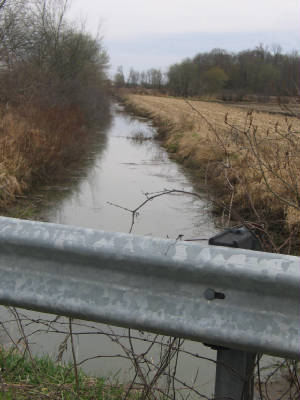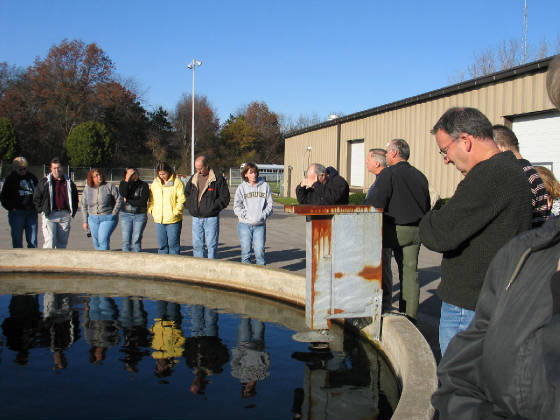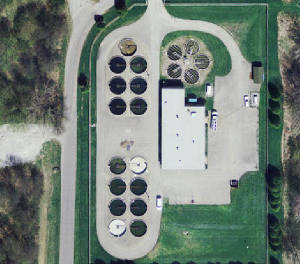|
Welcome to the Kingsbury communications page.
Use the guestbook below to post messages about issues and events in Kingsbury. This is a moderated site.
To view comments, click on "view guestbook."
 

Visit this site
to view 1850 Federal Census of Pleasant Twp.
Kingsbury Fish & Wildlife Area
| Mixsawba Fish Hatchery |

|
| Taken during Leadership LaPorte County's bus tour |
| These salmon will be stocked in local lakes. |

|
| Salmon eggs |

|
Kingsbury Fish & Wildlife Area is dedicated to providing quality hunting and fishing opportunities while maintaining 7,100
acres of grasslands, crop fields, thick brush, marsh areas and a 20 acre lake. The Kankakee River forms its south boundary.
Kingsbury is a remnant of the old Kingsbury Ordinance Plant which produced shells, cartridges and mortar rounds for World
War II and the Korean conflict. The land was deeded to the state of Indiana in 1965 by the federal General Services Administration,
and wildlife management began at that time.
Most revenues used in land acquisition, development, operation and maintenance of Kingsbury Fish and Wildlife Area are
derived from the sale of hunting, fishing and trapping licenses. Funds are also received from the federal Pittman-Robertson
and Dingell-Johnson programs to aid fish and wildlife restoration. These funds are derived from taxes levied on sport hunting
and fishing equipment. Indiana hunters, anglers and trappers are proud to provide this property for the enjoyment of all people.
Permits
In addition to a hunting and/or fishing license, the following permits are required:
- Permission to hunt on Kingsbury Fish and Wildlife Area must be obtained before entering the field. Hunting badges or one-day
hunting permit cards must be in the possession of the hunter at all times. Bagged game must be checked through the headquarters
or recorded through established self-service procedures outlined at the headquarters. Self-service drop boxes are located
throughout the property for your convenience. Contaminated areas are off limits at all times. If a wounded deer enters this
area, contact property personnel.
- Night hunting for raccoons is permitted in areas 5, 6 and 7 only.
- Dog training is available in Area 6 only. Sign up and obtain a permit at headquarters.
- Collecting Permits are required from the property manager or IDNR for the collection of anything except nuts, berries
and mushrooms.
Target Ranges
Target ranges are open to the public on a first come, first served basis. All shooters must obey range rules and regulations.
Park in designated lot only. Range hours may vary. Check with property headquarters for details. Target practice in established
ranges only. Fees are charged. Phone: (219) 393-1128. Traffic Traffic on public roads through the area is
governed by state and county laws. Traffic over service roads and trails, except by authorized vehicles, is restricted to
walking. Park in designated lots only. Speed limit is 30 MPH unless otherwise posted. No horses, snowmobiles, ATVs or off-road
vehicles are allowed. No hunting within 50 feet of any public road.
FISHING
- Kingsbury Fish and Wildlife Area provides fishing areas along the Kankakee River, drainage ditches and 20 acre Tamarack
Lake.
- No check-in is required for fishing. All size and bag limits apply. See a copy of the current fishing regulations for details.
- Primary species include channel catfish, bluegill, crappie, largemouth bass, northern pike and rough fish.
- Boat ramps are located at parking area 5G for the Kankakee River and 5A for Tamarack Lake. A maximum 12-volt electric
motor for lakes, gas motors allowed on the river.
- Shoreline fishing is located along the drainage ditches and Kankakee River.
HUNTING
- Deer, pheasant, rabbit, squirrel, furbearers, dove, duck, goose and wild turkey are common at Kingsbury Fish & Wildlife
Area.
- Daily check-in is required or all species. See the hunting and trapping guide (http://www.in.gov/dnr/fishwild/3089.htm) for seasons and bag limits.
- The use of bonus antlerless deer permits is NOT allowed.
- Special hunts include waterfowl reservations, youth waterfowl hunt, reserved turkey hunts and early rabbit season. Standby drawings are held on all pre-drawn or reservation days.
- Daily waterfowl drawings begin at 4:30 a.m. local time. Waterfowl hunting hours end at 1 p.m. local time during the regular
season.
- Kingsbury Fish and Wildlife Area headquarters operates a deer and turkey check station.
- The use of hunting dogs is allowed.
- Only male (cock) pheasants may be taken. Put take pheasant hunts are not offered at Kingsbury Fish and Wildlife Area.
- Tree stands are allowed at 12 noon from Sept. 1 through Jan. 10.
WILDLIFE
7,100 acres of fallow land, crop fields, thick brush, grass lands, water ways and scattered stands of conifers and hardwoods
attract hawks, owls, bald eagles, shorebirds, wading birds and a wide variety of resident and migrating songbirds.
SHOOTING RANGE
- The shooting range is safe, modern and staffed by qualified range officers.
- Use of eye and ear protection is required of all participants and observers.
- The range has 37 shooting positions: 10 positions at 50 yards, five positions at 100 yards, 18 positions at 10,15 or 25
yards, and four shotgun stations.
- Bring your own paper targets or clay birds.
- Indoor restrooms accessible to persons with disabilities are available.
- Range is open Tuesday-Sunday, 9 a.m.CST to dusk (varies by season, call to check time).
- Fees for the range are $4 a day for age 18 and older, $2 a day for younger than 18 (under 18 must be accompanied by an
adult), $10 a day for a family (ex: 2 adults and 2 children).
- Target practice is permitted only in established ranges.
- Call 219-393-1128.
ARCHERY RANGE
The archery range is open to the public, 7 days a week, all daylight hours, first come, first served. Bring your own targets.
Shooters must obey all range rules and regulations. Parking is permitted only in designated lot.
ADDITIONAL OPPORTUNITIES
- Wetland trapping is available through drawing only. Drawing is held the first Saturday in October.
- A dog training area is provided in area 6 (see map).
- Resident and non-resident licenses and stamps are sold at the headquarters.
- Wild blackberries, raspberries, mushrooms and nuts may be gathered from the property.
- Mixsawbah State Fish Hatchery is located on Kingsbury Fish and Wildlife Area.
- Fish Lake Wetland Conservation Area is 11 miles from the headquarters.
- Galena Wetland Conservation Area is 18 miles from the headquarters.
| Mixsawba Fish Hatchery aerial view |

|
The hatchery was constructed in 1974 for the propagation of salmonids (trout & salmon) to enhance Indiana’s
Lake Michigan fishery. The hatchery’s name honors Chief Mixsawbah, a Potawatomi Indian chief whose local domain
was near the Kankakee River in northwestern Indiana.
Mixsawbah annually produces 670,000 salmonids, with a total weight of about 35,500
pounds. Production includes chinook salmon, coho salmon, and steelhead trout. Most of these fish are stocked into
tributary streams to Lake Michigan. In Indiana, these streams are Trail Creek in LaPorte County and the East Branch
of the Little Calumet River in Porter County.
SALMON - THE LAKE MICHIGAN STORY
In 1966, the state of Michigan stocked 600,000 young coho salmon into Lake Michigan tributaries. Biologists
watched the progress of the cohos until they entered Lake Michigan. For the next several months, the fish vanished. stay
offshore in cooler water preparing to return to their home streams each autumn.
The Indiana Department of Natural Resources began stocking salmon and trout fingerlings in the Indiana waters
of Lake Michigan in 1968. In September, 1971, 25 Indiana-reared cohos were trapped from Trail Creek, and the first Hoosier
salmon run was off to a flying start. About 10% of the original fish returned to Trail Creek.
The fish penetrated to the headwaters and spawned. Little success is expected from this natural reproduction,
however, because natural survival is low in Indiana tributaries to Lake Michigan. This means the Lake Michigan salmonid
program is totally manageable. The fishery is dependent on hatchery production and can be regulated by adjusting stocking
numbers. Mixsawbah was built in 1974 to produce 500,000 trout and salmon annually to meet the demands of the new fishery.
WATER SUPPLY
Water for the hatchery is supplied by three wells located about 3/4 mile west of the facility. One
well provides operational water, while the remaining wells assume emergency standby positions. Water from the wells is
52°F., an excellent temperature for raising trout and salmon. Each well can supply 640 gallons per minute (gpm) to the
building where the water passes through an aeration chamber to add oxygen. The aerated water is then pumped through mechanical
filters to reduce the iron content. The filtered water is aerated again in the aeration chamber and overflows into a
reservoir that supplies the egg incubators and the inside rearing tanks. At full capacity, the inside system uses 300
gpm. Water not used for inside rearing overflows from the reservoir to a second storage basin that supplies the outside
rearing ponds. Each outside pond uses up to 200 gpm. The operation of all 15 ponds requires 3,000 gpm. To make
up the difference between the 640 gpm supplied from the well and the 3,000 gpm required, and to conserve water and energy,
water is recycled. The used water from the incubators, rearing tanks, and the rearing ponds is collected in biological
filters located north of the building. The biofilters harbor bacteria; which convert ammonia, the major excretory product
of fish, to harmless nitrates. The reconditioned water flows from the biofilters to a clearwell under the building where
it is pumped up through an aeration chamber and overflows to the storage basin supplying the outside rearing ponds. When
all 15 ponds are full, water will remain in the rearing pond recycle system for about 8 hours before it overflows to
waste. Water leaving the hatchery is tested to meet federal, state and local water quality standards.
FISH REARING
Eggs are collected from adult fish returning to Indiana streams to spawn or are obtained through agreements
with other states. At Mixsawbah, the eggs are disinfected to prevent the spread of disease prior to placing them in Heath
Vertical Egg Incubators. The incubators provide a continuous flow of water and oxygen around each egg throughout the
incubation process. There are 184 incubation trays at the hatchery, each capable of holding from 5,400 to 16,000 eggs,
depending on the species. The eggs remain in the incubators about one month before they hatch. After hatching, the
small fry remain in the trays for about 20 days, living and developing on the nutriments stored in their yolk sac. At
the end of 20 days, the yolk is mostly absorbed and the young fry are ready to accept feed. At this time, the trout
are transferred to the 18 inside rearing tanks, while the larger salmon are placed in the 15 outside rearing ponds.
The young trout remain in the rearing tanks for several months before they are transferred to the outside
rearing ponds as 2.5 inch fingerlings. Each inside tank can hold 10,000, 2.5 inch fish. Each outside pond can hold
100,000, 3 inch fish or 16,500, 7 inch fish. Each rearing pond has a nameplate attached to the automatic feed hopper
which identifies the species in that particular pond.
Fingerling salmonids are fed a nutritionally balanced, high protein diet from automatic feeders. Feed
is dispensed every half hour for 18 hours per day. Salmonids readily learn to accept the artificial diet, but it is up to
hatchery personnel to develop an efficient feeding program. Every hatchery manager wants to produce healthy fish with
as little feed as possible. A trout must eat 1.25 pounds of food to gain one pound in weight. Fingerling salmonids
are started on crumbles, a very fine granule the size of table salt. As the fish grow, the size of the feed particle
is increased. Fish that are 6 inches in length can efficiently feed on 1/8 inch pellets.
Three species of salmonids are reared at Mixsawbah. Chinook salmon are stocked
in the streams at five months of age or 3.5 inches in length. The other species are kept in the rearing ponds for 7-14 months where they grow to a size of 4.25 to 7 inches before being released.

|

